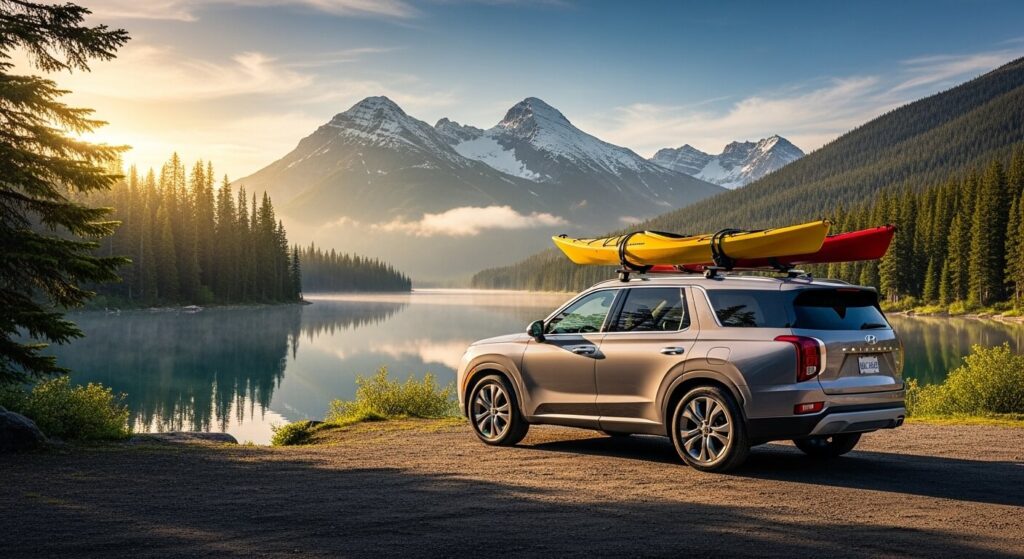Finding the best kayak rack for Hyundai Palisade isn’t just about tossing gear on the roof and hoping for the best. You want something that fits tight, handles highway wind without rattling like a loose toolbox, and actually makes loading less of a back-breaking chore. After running through a pile of options and weighing stuff like build strength, ease of install, and how it matches the Palisade’s roof shape, one stood out clearly. The Thule Hullavator Pro takes that top spot—it’s rugged, designed for heavy use, and the lift-assist feature cuts the awkward wrestling match in half, making it the smartest pick if you’re serious about hauling kayaks safely and with less sweat.
Best 5 Kayak Racks for Hyundai Palisade
01. Thule Hullavator Pro Kayak Carrier
The Thule Hullavator Pro Kayak Carrier is one of those rare roof rack systems that actually changes how you handle loading and unloading. Built with gas-assisted struts, it lowers the kayak down to car-door height, cutting the heavy lifting in half and saving your shoulders. Whether you’re hauling a touring kayak, sea kayak, or recreational model, the Hullavator Pro fits well with crossbars like Thule WingBar Evo, AeroBlade, or ProBar, making it an option for SUV, crossover, or pickup truck owners who want a roof-mounted solution. For anyone tired of awkward rooftop balancing acts, this side-load assist system stands out.
Pros:
- ✅ Gas-assisted struts support up to 40 lbs of lifting weight
- ✅ Allows side-of-vehicle loading at waist height
- ✅ Works with wide range of crossbars (Thule WingBar Evo, AeroBlade, ProBar)
- ✅ Durable corrosion-resistant construction
Cons:
- ❌ Higher price compared to standard kayak racks
- ❌ Adds bulk on top of roof when not in use
- ❌ Requires compatible crossbars for installation
02. Malone J-Pro 2 J-Style Universal Car Rack
The Malone J-Pro 2 J-Style Universal Car Rack is built for paddlers who want a simple yet tough way to carry their kayak. Made from heavy-duty steel with corrosion-resistant coating, this kayak rack fits most crossbars and is designed to keep your boat secure on long drives. Its wide-mouth J-cradle makes loading and unloading kayaks easier, while the padding helps protect the hull. Whether you’re hauling a fishing kayak, touring kayak, or recreational model, this rack offers dependable support without overcomplicating the setup.
Pros:
- ✅ Fits most factory and aftermarket crossbars
- ✅ Strong steel build with corrosion-resistant finish
- ✅ Padded cradles protect kayak hulls
- ✅ Universal fit for different kayak styles
Cons:
- ❌ Can take up roof space if you’re hauling multiple kayaks
- ❌ Straps may need upgrading for heavier boats
This kayak carrier is especially popular among weekend paddlers and outdoor travelers looking for reliable transport. The J-cradle design not only maximizes roof space but also helps with stability at highway speeds. Compatible with SUVs, trucks, and cars equipped with crossbars, the Malone J-Pro 2 gives peace of mind when driving to the lake, river, or coastal launch site.
03. TMS Kayak Roof Racks
The TMS Kayak Roof Racks are a solid pick for anyone looking to carry their kayak, canoe, or even paddleboard safely on top of their car or SUV. Built with heavy-duty steel, these racks offer strong support and stability on highway drives and bumpy backroads alike. They fit most crossbars, which makes them practical if you swap vehicles or share gear with friends. The J-bar design not only secures your kayak snugly but also leaves room for extra gear like bikes or surfboards on larger vehicles.
Pros ✅
- ✅ Heavy-duty steel construction for durability
- ✅ J-bar design saves space for multiple items on roof
- ✅ Fits most crossbars on SUVs, cars, and trucks
- ✅ Affordable price point compared to similar kayak carriers
Cons ❌
- Padding could be thicker to better protect kayak hulls
- Installation may take more time for beginners
- Straps included aren’t as strong as aftermarket tie-downs
04. AA-Racks 2 Pair J-Bar Rack
The AA-Racks 2 Pair J-Bar Rack is a solid choice for carrying kayaks, canoes, or even paddleboards when you’re hitting the water on weekends. Built with a heavy-duty steel frame and padded bars, it helps protect your kayak’s hull while keeping everything snug on top of your SUV, truck, or crossover. The wide-mouth design makes loading and unloading less of a struggle, especially when you’re dealing with bulkier boats. It’s compatible with most crossbars, making it a practical option for people who use Thule, Yakima, or factory-installed racks.
Pros
- ✅ Holds up to 2 kayaks at once (4 J-bars total)
- ✅ Sturdy steel construction with adjustable padding
- ✅ Works with square, round, and most factory crossbars
- ✅ Affordable compared to similar kayak rack systems
Cons
- ❌ May require tools for installation/removal
- ❌ Not ideal for very wide fishing kayaks
- ❌ Padding could wear out after extended heavy use
This rack is often favored by paddlers who want extra capacity without spending big on premium carriers. If you’re running a Hyundai Tucson, Ford F150, Subaru Outback, or Toyota RAV4, the AA-Racks J-Bar system fits right in and gives you the confidence to haul your kayak, canoe, or SUP securely. It’s a budget-friendly way to get your boats to lakes, rivers, or the coast without worrying about stability.
05. HIGHRAZON Kayak Roof Rack
The HIGHRAZON Kayak Roof Rack is built for folks who want a no-fuss way to load and secure their kayak on top of their car, SUV, or truck. It’s made with sturdy steel construction, and the padded cradles help keep your kayak, canoe, or even paddleboard from scratching during transport. The universal mounting hardware fits most crossbars, making it a reliable pick for outdoor trips whether you’re heading to a river, lake, or the beach. Its foldable design also means you don’t have to remove it every single time—it just flips down when not in use.
Pros ✅
- ✅ Fits most car roof crossbars and racks
- ✅ Heavy-duty steel frame for stability
- ✅ Foam padding protects kayak or canoe from damage
- ✅ Foldable for easy storage when not in use
- ✅ Can carry kayaks, canoes, and SUPs
Cons ❌
- ❌ Installation can feel tricky for beginners
- ❌ May cause wind noise when driving fast
- ❌ Works best with lighter kayaks, not oversized fishing models
How to Choose The Best Kayak Racks for Hyundai Palisade
The Hyundai Palisade is a big SUV, roomy enough for families, dogs, snacks that roll under the seats and never come back, but throw in a kayak and suddenly that roomy feeling vanishes. You’re stuck with one obvious solution: put the boat on the roof. And that’s where the headaches begin, because roof racks, kayak racks, J-cradles, saddles, crossbars—there are more options than flavors of potato chips. Picking the right one feels like shopping for shoes that have to fit two people at once.
The roof itself isn’t a blank canvas
Palisades usually come with side rails, sometimes flush, sometimes raised. Without crossbars, though, those rails are like having a belt with no buckle. You need crossbars before even thinking about kayak racks. Hyundai’s own crossbars have a weight rating of around 165 pounds dynamic load. That means while driving, your roof can safely hold about that much, rack included. A single kayak might weigh 40–70 pounds, so two boats plus the rack system can push limits faster than you’d expect. People forget this all the time, assuming a massive SUV roof can hold anything. It can’t. Wind drag, weight distribution, and rack design all play roles.
J-cradles vs saddles, the endless debate
J-cradles tilt the kayak on its side, saving roof space for maybe another kayak or cargo box. Saddles let the boat rest flat, hull down. Which is better? Depends. If you’ve got heavy fishing kayaks (some push 100 pounds easy), lifting them into J-cradles feels like wrestling a wet log over your head. Saddles are easier for solo loading. But J-cradles give you clearance to carry two boats side by side on a Palisade, assuming you’ve got decent width crossbars.
Statistics on injuries from loading kayaks aren’t widely published, but anecdotal evidence is everywhere: strained backs, smashed fingers, cracked rear windows from dropping the stern too hard. Choosing a style of rack is partly about sparing yourself chiropractor visits.
Foam blocks and budget hacks
Not everyone wants to spend $400 on racks. Foam block kits exist, cheap, $40 or so, but let’s be honest—they’re temporary solutions. Great for short trips at low speed. Terrible in high wind or long highway drives. They also scuff paint if not placed carefully. If you’ve got a Palisade, odds are you’re already into comfort and stability, so balancing a kayak on foam blocks tied with ratchet straps feels like wearing flip-flops to hike a mountain trail.
Straps and tie-downs, the unglamorous but vital piece
The rack holds the kayak, but straps keep it there. Cam buckle straps are safer than ratchet straps (ratchets can crush kayak hulls if overtightened). And always—always—use bow and stern tie-downs. The Palisade has solid tow points for this, but I’ve seen people skip them, trusting just the rack. At 70 mph, wind forces on a kayak can exceed hundreds of pounds of uplift, enough to rip a rack loose. News reports occasionally cover accidents where boats flew off SUVs. Nobody wants that headline.
Loading systems, because not everyone’s tall or strong
The Palisade’s roof height is about 68.9 inches without racks. Add crossbars and racks, and lifting a kayak overhead becomes a chore for anyone under six feet. That’s why brands sell load-assist racks—sliding rollers, lift systems, even mechanical arms that lower the rack to waist height. They cost more, sometimes $600–$800, but for frequent kayakers or older folks, it’s the difference between paddling on weekends and giving up altogether.
I once saw a couple trying to load a tandem kayak onto a tall SUV in a windy parking lot. Took them 25 minutes, lots of yelling, and at one point the kayak nearly clipped another car. A $500 lift system would’ve saved them a near-divorce.
Brand names that dominate the space
You’ll hear the same names again and again: Thule, Yakima, Malone, Rhino-Rack. Each has pros and quirks. Thule tends to cost more but feels engineered like aircraft parts. Yakima offers versatility and accessories galore. Malone is often the budget-friendly but still solid option. Rhino-Rack appeals to people who like overbuilt, rugged gear.
For a Palisade, the decision often comes down to crossbar compatibility. Hyundai’s factory crossbars have a specific profile that not every aftermarket rack clamps onto easily. Many owners upgrade to stronger aftermarket crossbars (like Thule WingBars) to open more rack choices.
Seasonal considerations
Hot summers and freezing winters both punish racks. UV rays weaken plastic parts, and road salt corrodes bolts. Maintenance matters—spray silicone on moving parts, rinse after coastal trips, check bolts twice a season. According to outdoor gear surveys, nearly 30% of roof rack failures trace back to loose or rusted hardware.
My not-so-clean conclusion
So how do you choose the best kayak rack for a Hyundai Palisade? Start with weight limits, both kayak and rack combined. Decide if you’re usually loading solo or with help—that alone determines J-cradle or saddle. If budget is tight, foam blocks work but don’t kid yourself about long highway safety. Spend more if you’ll use the system often. And don’t forget the little stuff—straps, tie-downs, load assists—because the kayak itself doesn’t care how nice your SUV looks when it’s airborne on the freeway.






